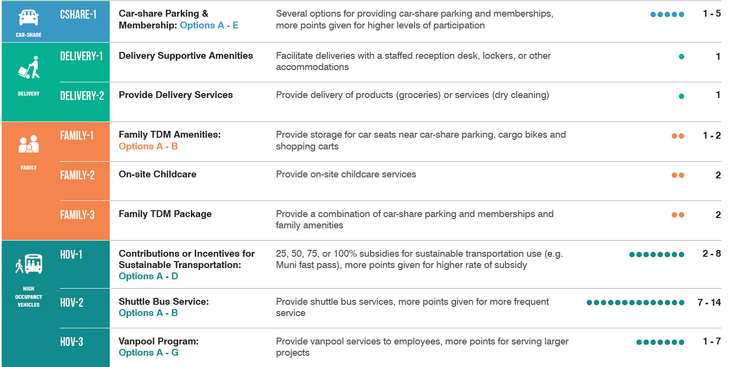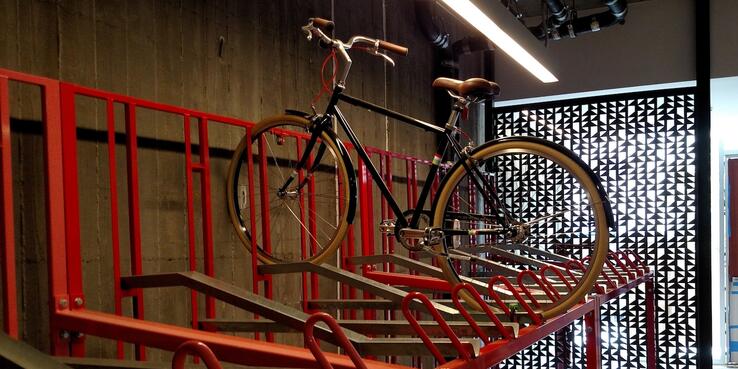How do you keep people moving and avoid gridlock in a city that’s poised to add 190,000 jobs and 100,000 households over the next 25 years? For San Francisco, solving this problem is not a thought experiment — it’s reality. To address this issue, the city is enlisting developers in making sure their new projects don’t add up to thousands more car trips.
Last week, the San Francisco Board of Supervisors passed the Transportation Demand Management (TDM) Ordinance. The TDM program, which the ordinance establishes, is the third prong of the city’s Transportation Sustainability Program, a set of three policy initiatives focused on improving the transportation system to accommodate new growth.
A joint effort of the San Francisco Municipal Transportation Agency, the San Francisco Planning Department and the San Francisco County Transportation Authority, the program requires developers to provide on-site amenities to help limit the number of car trips that residents, workers and visitors will make to and from the property. It applies to most new buildings, as well as to buildings where a change in land use will impact the estimated number of vehicle trips. While the program drew inspiration from TDM regulations across the country, it is the first to cover both residential and non-residential uses.
To help developers meet the requirement, city staff members have developed a menu of more than 60 TDM tools — things like discounted transit passes, free shared bikes, on-site car sharing and bicycle parking — that are proven to reduce driving. Each measure is allocated a point value based on its ability to reduce the number of vehicle miles people collectively travel per year to get to and from the property. Providing showers and lockers earns a developer 1 point, and offering car share parking and/or membership can earn up to 5 points. New developments will be assigned a point target based on the type of land use and the number of parking spaces their project proposes. To reach the target, developers will need to choose a selection of TDM measures from the menu. The agencies created an online tool to help developers navigate the process.

A sample section of the TDM menu, courtesy of the San Francisco Planning Department
There’s a lot to like in the TDM program. It’s strategic, transparent and consistent. Historically, if a new development included anything beyond the standard requirements of car-sharing and bicycle parking — like a bicycle repair station, transit contributions or other TDM measures — it was usually voluntary, at the request of the Planning Commission or required as a mitigation following an environmental review. Now, it’s a priority for all projects; amenities that help reduce car trips must be incorporated into a project from the start or else the developer won’t get the green light to build. The program is data driven and offers flexibility: developers can select whatever assortment of amenities they think will best meet the needs of their building’s future inhabitants, as long as they meet their points target. The program stands out for its inclusion of family-friendly amenities like loaner cargo bikes, on-site day care and providing storage for car seats near car-share parking.
Crucially, the TDM program doesn’t ignore monitoring and evaluation. It will require developments to demonstrate ongoing compliance, and city officials will study the impacts of the different amenities on people’s transportation choices and use the results to tweak the program. Because the buildings in the program will be located throughout the city, city staff will be able to collect fine-grain data on what amenities work best where, as well as learn how new development impacts the transportation system. The resulting trove of data will provide real information that will be vital for future planning efforts.
All too often programs call for monitoring and evaluation but don’t include the funding for it. The TDM Program involves two fees to cover costs: an upfront TDM plan application fee and an on-going monitoring/compliance fee. The later fee will fund needed staff.
TDM programs tend to focus on the commute, but the bigger win is when people turn to biking, walking and transit for all sorts of trips, not just getting to work. The amenities in San Francisco’s TDM program are trip agnostic; they don’t care if they support a work trip or a trip to the grocery store or a to friend’s house. An increase in sustainable trips benefits not only the local neighborhood, but the city and region as a whole.
The TDM program won’t eliminate congestion in San Francisco, but it’s a piece of the puzzle. Ultimately, if growth and mobility are to coexist, city officials will need to employ a range of tools to make transit more convenient and biking and walking safer. Research shows that policies such as congestion pricing would help, as would transit-only lanes, protected bike lanes and more walkable streets. Planners should watch the TDM program closely, especially to see what happens when we make not driving the easiest, most obvious choice. The lesson of “defaulting” could provide an important framing for other aspects of transportation planning.
